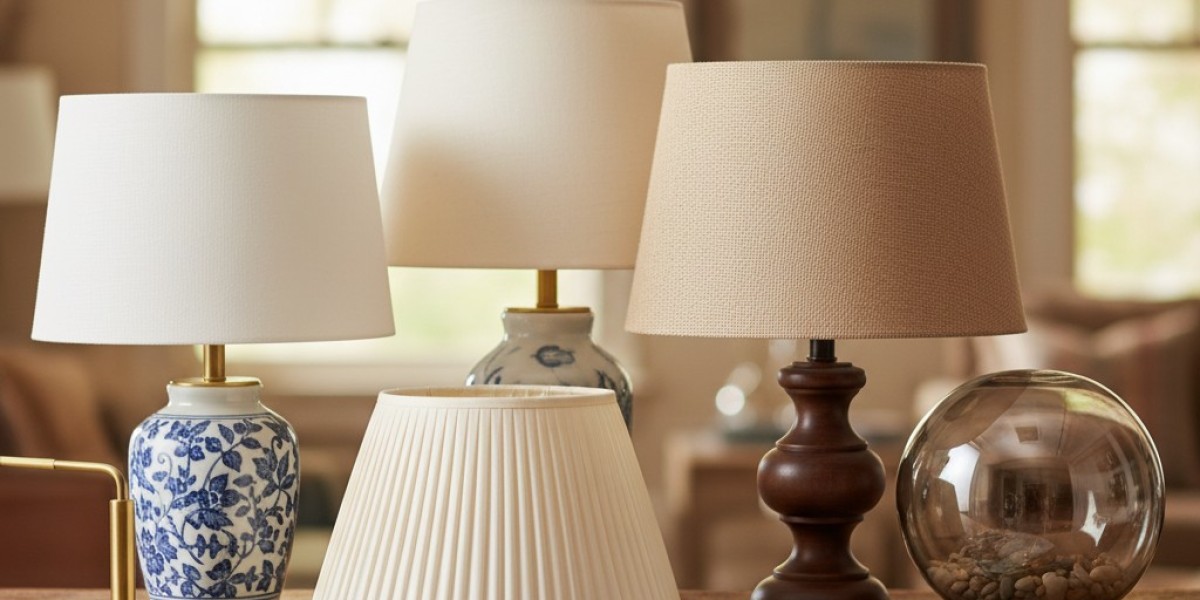Understanding the Importance of Lamp Shades
A table lamp shade is not just a decorative accessory; it serves a functional purpose as well. The shade controls how light is dispersed in the room, affecting both brightness and ambiance. For desk lamps, the right shade can reduce glare and create focused lighting for work or study, while table lamps in living rooms or bedrooms rely on their shades to add a warm, cozy glow. Therefore, picking the right lamp shade is essential to balance style and utility.
Consider the Size and Shape of Your Table Lamp
The first step in choosing a lamp shade is understanding the proportions of your table lamp or desk lamp. A shade that is too small may make your lamp look awkward, while an oversized shade can overwhelm your furniture. Typically, the height of the shade should be about two-thirds the height of the lamp base. For wider lamp bases, consider a shade with a broader diameter to maintain balance. Shapes matter too. Drum shades offer a modern look, bell shades are more traditional, and empire shades work well for classic styles. Always keep in mind the style of the room and the function of your lamps when selecting the shape.
Choosing the Right Material for Your Lamp Shade
Lamp shades come in a variety of materials, each affecting the way light is distributed. Linen and cotton shades offer a soft, diffused glow, making them ideal for table lamps in bedrooms and living areas. Silk shades, on the other hand, provide a touch of elegance and are perfect for decorative lamps. For a modern or minimalist office, a metal or glass shade on a desk lamp can create a sleek, contemporary appearance while offering targeted lighting for tasks. Additionally, consider the colour and pattern of the material. Light-colored shades will brighten a room, while darker shades can create a more intimate atmosphere.
Matching Lamp Shades with Room Décor
Your lamp shade should complement the décor of the room. For traditional interiors, ornate shades with classic patterns can enhance the overall theme, while minimalist or modern rooms benefit from simple, clean-lined shades. It is important to coordinate your table lamp or desk lamp with the surrounding furniture, wall colours, and decorative accents. For instance, a neutral-toned shade can blend seamlessly with most settings, while a bold-colored or patterned shade can serve as a statement piece, drawing attention to your lamps as both a functional and decorative feature.
Functionality: Light Direction and Brightness
Different lamp shades affect light direction differently. For a desk lamp, consider shades that focus light downward, providing direct illumination for reading, writing, or working on a computer. On the other hand, table lamps meant for ambient lighting benefit from shades that allow light to diffuse both upward and downward, creating a warm and welcoming atmosphere. Additionally, consider the bulb type you plan to use. LED bulbs, incandescent bulbs, and energy-efficient options interact differently with various shades. Ensuring compatibility is essential to achieve the desired lighting effect.
Considering Lamp Shade Fittings and Styles
Lamp shades attach to bases in different ways, and choosing the right fitting ensures stability and safety. Common fittings include spider, clip-on, and uno fittings. The desk lamp often works best with clip-on or smaller shades that can easily direct light to the desired spot. For table lamps, spider fittings are popular and versatile, allowing for various finial styles. The style of the shade should also complement the lamp base. For example, a tall, slender table lamp might pair beautifully with a drum or empire shade, while a shorter base may look better with a bell-shaped shade.
Budget Considerations and Quality
While it’s tempting to go for the cheapest lamp shade available, investing in quality makes a difference in both aesthetics and longevity. Higher-quality materials maintain their shape and colour over time, while low-quality shades may sag, fade, or warp. Consider your budget, but also weigh the long-term benefits of a durable, stylish shade that enhances your lamps. Sometimes, spending a bit more upfront ensures your desk lamp or table lamp remains a functional and attractive part of your home for years.
Tips for Mixing and Matching Lamps and Shades
Mixing lamp bases with complementary shades can add depth and personality to your interior. For example, pairing a sleek, modern desk lamp with a fabric shade softens the industrial look while maintaining functionality. Similarly, a decorative table lamp with a neutral shade can fit into different rooms as your décor evolves. Consider the scale, style, and colour of both the lamp base and shade to create a cohesive look. Don’t be afraid to experiment with textures and patterns, as long as they enhance the overall aesthetic of your space.
Conclusion: Perfect Lamp Shades for Every Setting
Selecting the right lamp shade for your table lamp or desk lamp is a combination of style, function, and personal preference. By considering size, shape, material, light direction, and compatibility with your home décor, you can choose a shade that not only looks great but also enhances the lighting experience in your room. Whether you are updating your bedroom, living room, or home office, the perfect lamp shade can transform your lamps from simple lighting tools into essential design elements. Remember, the right shade not only illuminates your space but also reflects your style and personality.



